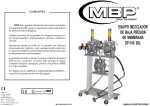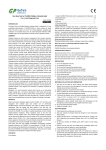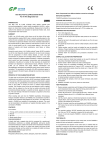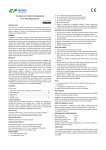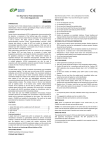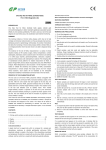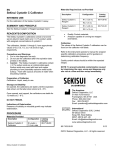Download User Manual
Transcript
One Step Test for CysC (Colloidal Gold) For in vitro Diagnostic Use Cat.# CG1008 User Manual INTENDED USE One Step Test for CysC (Colloidal Gold) is intended for in vitro quantitative determination of Cystatin C (CysC) in serum, plasma or whole blood. The test result is used as an aid in the assessment and evaluation of index of glomerular filtration rate, and has important application value in renal function, kidney damage and renal transplantation. SUMMARY Cystatin C (CysC) is mainly used as a biomarker of kidney function. Cystatin C has a low molecular weight (approximately 13.3 kilodaltons), and it is removed from the bloodstream by glomerular filtration in the kidneys. If kidney function and glomerular filtration rate decline, the blood levels of cystatin C rise. Serum levels of cystatin C are a more precise test of kidney function (as represented by the glomerular filtration rate, GFR) than serum creatinine levels. This finding is based mainly on cross-sectional studies (on a single point in time). Longitudinal studies (that follow cystatin C over time) are scarcer; some studies show promising results. Cystatin C levels are less dependent on age, sex, race and muscle mass compared to creatinine. Cystatin C measurement alone is not been shown to be superior to formula-adjusted estimations of kidney function. As opposed to previous claims, Cystatin C has been found to be influenced by body composition. It has been suggested that cystatin C might predict the risk of developing chronic kidney disease, thereby signaling a state of 'preclinical' kidney dysfunction. PRINCIPLE The test uses an anti-human CysC monoclonal antibody conjugated with colloidal gold and another anti-human CysC monoclonal antibody coated on the test line. After the sample has been applied to the test strip, the gold-labelled anti-human CysC monoclonal antibody binds with the CysC in sample and forms a marked antigen-antibody complex. This complex moves to the test card detection zone by capillary action. Then marked antigen-antibody complex is captured on the test line by another anti-human CysC monoclonal antibody resulting in a purplish red streak appears on the test line. The color intensity of the test line increases in proportion to the amount of CysC in sample. Then insert test card into FIA8000 Quantitative Immunoassay Analyzer (hereafter referred to as FIA8000), the concentration of CysC in sample will be measured and displayed on the screen. The value will be stored in FIA8000 and available for downloading. The result can be easily transmitted to the laboratory or hospital information system. CONTENTS A kit contains: 1. Getein CysC test card in a sealed pouch with desiccant ··················25 2. Disposable pipet·······································································25 3. User manual ··········································································1 4. SD card ·················································································1 5. Sample diluent ·········································································25 A test card consists of: A plastic shell and a reagent strip which is composed of a sample pad, nitrocellulose membrane (a colloidal gold-labelled anti-human CysC monoclonal antibody is coated at the border of the nitrocellulose membrane and sample pad, the test line is coated with another anti-human CysC monoclonal antibody, and the control line is coated with rabbit anti-mouse IgG antibody), absorbent paper and liner. Sample diluent: Phosphate buffered saline, proteins, detergent, preservative, stabilizer. Note: Do not mix or interchange different batches of kits. APPLICABLE DEVICE FIA8000 Quantitative Immunoassay Analyzer STORAGE AND STABILITY Store the test card at 4~30℃ with a valid period of 24 months. Use the test card within 1 hour once the foil pouch is opened. Store the sample diluent at 0~30℃ with a valid period of 24 months. Store the sample diluent at 2~8℃ for better results. PRECAUTIONS 1. 2. 3. 4. 5. 6. 7. 8. For in vitro diagnostic use only. For professional use only. Do not use the kit beyond the expiration date. Do not use the test card if the foil pouch is damaged. Do not open pouches until ready to perform the test. Do not reuse the test card. Do not reuse the pipet. Handle all specimens as potentially infectious. Proper handling and disposal methods should be followed in accordance with local regulations. 9. Carefully read and follow user manual to ensure proper test performance. SPECIMEN COLLECTION AND PREPARATION 1. This test can be used for serum, plasma and whole blood samples. Sodium citrate or EDTA can be used as the anticoagulant for plasma and whole blood. Samples should be free of hemolysis. 2. Suggest using serum or plasma for better results. 3. If testing will be delayed, serum and plasma samples may be stored up to 7 days at 2~8℃ or stored at -20℃ for 6 months before testing (whole blood sample may be stored up to 3 days at 2~8℃). 4. Refrigerated or frozen sample should reach room temperature and be homogeneous before testing. Avoid multiple freeze-thaw cycles. 5. Do not use heat-inactivated samples. 6. SAMPLE VOLUME: 10 μl. TEST PROCEDURE 1. Collect specimen according to user manual. 2. Test card, sample and reagent should be brought to room temperature before testing. 3. Confirm SD card lot No. in accordance with test kit lot No.. Perform “QC (SD)” calibration when necessary (Details refer to 8.2.1 of FIA8000 User Manual). 4. On the main interface of FIA8000, press "ENT" button to enter testing interface. 5. Remove the test card from the sealed pouch immediately before use. Label the test card with patient or control identification. 6. Put the test card on a clean table, horizontally placed. 7. Using sample transfer pipette, deliver 10 μl of sample into one tube of sample diluent, mix gently and thoroughly. Then drop 120 μl of sample mixture (or 4 drops of sample mixture when using disposable pipet) into the sample port on the test card. 8. Reaction time: 3 minutes. Insert the test card into FIA8000 and press "ENT" button after reaction time is elapsed. The result will be shown on the screen and printed automatically. Notes: 1. It is required to perform “QC (SD)” calibration when using a new batch of kit. 2. It is suggested to calibrate once for one batch of kit. 3. Make sure the test card insertion is correct and complete. TEST RESULTS Valid: When a purplish-red band appears at the control area(C), use FIA8000 to analyze the test card and get the result. Invalid: If no colored band appears in the control area (C), the test result is invalid. The test should be repeated and if the same situation happened again, please stop using this batch of products and contact your supplier. EXPECTED VALUE The expected normal value for CysC was determined by testing samples from 233 apparently healthy individuals. The reference range of CysC is 0.51 mg/L~1.09 mg/L calculated by using normal distribution methods. It is recommended that each laboratory establish its own expected values for the population it serves. DESCRIPTION OF SYMBOLS USED PERFORMANCE CHARACTERISTICS The following graphical symbols used in or found on One Step Test for CysC (Colloidal Gold) are the most common ones appearing on medical devices and their packaging. They are explained in more details in the European Standard EN 980:2008 and International Standard ISO 15223-1:2007. Measuring Range 0.5~10.0 mg/L Lower Detection Limit ≤0.5 mg/L Within-Run Precision ≤10% Between-Run Precision ≤15% Method Comparison: The assay was compared with HITACHI 7170A analyzer and its matching MAKER CysC test kits with 204 serum samples (30 positive samples and 174 negative samples). The correlation coefficient (r) is 0.985. Key to symbols used Manufacturer Expiration Date Do not reuse Date of manufacture Consult instructions for use Batch code Temperature limitation In vitro diagnostic medical device Sufficient for Authorized representative in the European Community LIMITATIONS 1. As with all diagnostic tests, a definitive clinical diagnosis should not be made based on the result of a single test. The test results should be interpreted considering all other test results and clinical information such as clinical signs and symptoms. 2. Samples containing interferents may influence the results. The table below listed the maximum allowance of these potential interferents. Interferent Hemoglobin Triglyceride Bilirubin Concentration (Max) 10 g/L 10 g/L 0.2 g/L REFERENCES 1. Bjurman C, Snygg-Martin U, Olaison L, et al. Cystatin C in a composite risk score for mortality in patients with infective endocarditis: a cohort study. BMJ Open. 2012, Jul 12, 2(4). 2. Chae HW, Shin JI, Kwon AR, et al. Spot urine albumin to creatinine ratio and serum cystatin C are effective for detection of diabetic nephropathy in childhood diabetic patients. J Korean Med Sci. 2012, 27(7):784-787. 3. Odutayo A, Cherney D. Cystatin C and acute changes in glomerular filtration rate. Clin Nephrol. 2012, 78(1): 64-75. 4. EN ISO 18113-1:2009 In vitro diagnostic medical devices - Information supplied by the manufacturer (labelling) - Part 1: Terms, definitions and general requirements. 5. EN ISO 18113-2:2009 In vitro diagnostic medical devices - Information supplied by the manufacturer (labelling) - Part 2: In vitro diagnostic reagents for professional use (ISO 18113-2:2009). CE mark Thank you for purchasing One Step Test for CysC (Colloidal Gold). Please read this user manual carefully before operating to ensure proper use. Version: WCGDL-SM-11-01 GeTein BioMedical Inc. 4640 SW Macadam Avenue, Suite 130C; Portland, OR 97239, USA Tel: 1-971-407-3868 Fax: 1-971-407-3868 E-mail: [email protected]; [email protected] Website: www.gp-diagnostics.com


